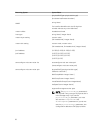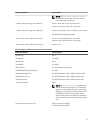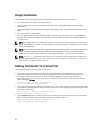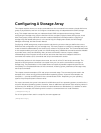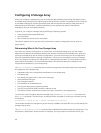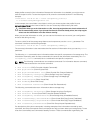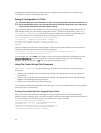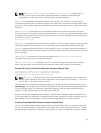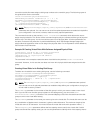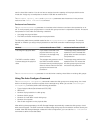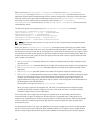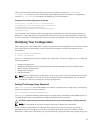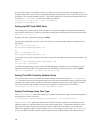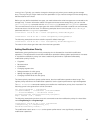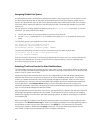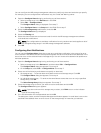
controller module firmware assigns a disk group number to the new disk group. The following syntax is
the general form for the command:
create virtualDisk physicalDiskCount=
numberOfPhysicalDisks raidLevel=(0 | 1 | 5 | 6)
userLabel="virtualDiskName" [physicalDiskType=
(SAS)] [capacity=virtualDiskCapacity | owner=(0 |
1) | segmentSize=segmentSizeValue]
[enclosureLossProtect=(TRUE | FALSE)])
NOTE: The physicalDiskType, capacity, owner, segmentSize, and enclosureLossProtect
parameters are optional. You can use one or all of the optional parameters as needed to help define
your configuration. You do not, however, need to use any optional parameters.
This command is similar to the previous create virtualDisk command, which allows the user to
assign the physical disks. This version of the command requires only the number and the type of physical
disks to use in the disk group. You do not need to enter a list of physical disks. All other parameters are
the same. Enclosure loss protection is performed differently when MD Storage Manager assigns the
physical disks as opposed to when a user assigns the physical disks. For an explanation of the difference,
see Enclosure Loss Protection.
Example Of Creating Virtual Disks With Software-Assigned Physical Disks
client>smcli 123.45.67.89 -c "create virtualDisk
physicalDiskCount=3 raidLevel=5 userLabel=
\"Engineering_1"\ capacity=20 GB owner=0
segmentSize=64;"
The command in this example creates the same virtual disk as the previous create virtualDisk
command. However, in this case the user does not know which physical disks are assigned to this disk
group.
Creating Virtual Disks In An Existing Disk Group
To add a new virtual disk to an existing disk group, use the following command:
create virtualDisk DiskGroup=diskGroupNumber
userLabel="virtualDiskName" [freeCapacityArea=
freeCapacityIndexNumber | capacity=
virtualDiskCapacity | owner=(0 | 1) | segmentSize=
segmentSizeValue]
NOTE: The freeCapacityArea, capacity, owner, and segmentSize parameters are optional.
You can use one or all optional parameters as needed to help define your configuration, though you
do not need to use any of them.
The diskGroup parameter is the number of the disk group in which you want to create a new virtual
disk. If you do not know the disk group numbers on the storage array, you can use the
show
allVirtualDisks summary command. This command displays a list of the virtual disks and the disk
groups to which the virtual disks belong.
The userLabel parameter is the name you want to give to the virtual disk. The virtual disk name can be
any combination of alphanumeric characters, hyphens, and underscores. The maximum length of the
virtual disk name is 30 characters. You must enclose the virtual disk name with quotation marks (" ").
The freeCapacityArea parameter defines the free capacity area to use for the virtual disk. If a disk
group has several free capacity areas, you can use this parameter to identify which free capacity area to
44



